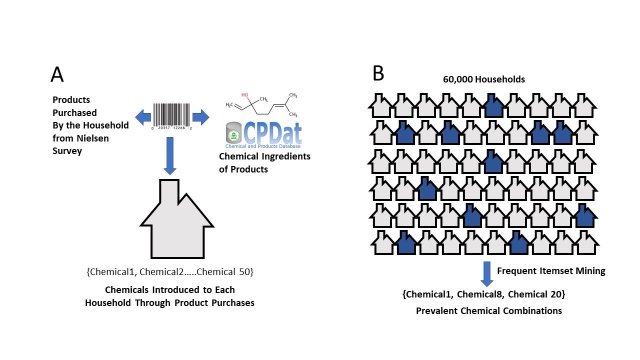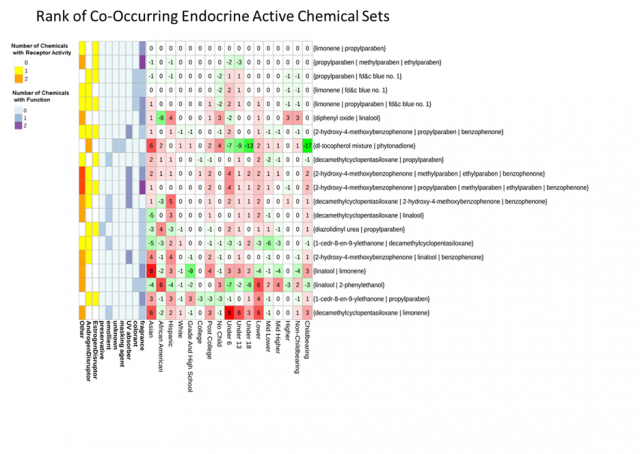EPA Researchers Evaluate In-Home Chemical Exposures

Published October 5, 2021
Most people do not think about it, but every day we are exposed to an array of chemicals in our cleaning products, cosmetics, furniture, hair care products and more. While we may understand the risks from specific, individual common household chemicals, scientists do not fully understand the risks of exposure to multiple chemicals at the same time, called co-exposures.
In a first-of-its-kind approach, EPA researchers are using techniques to help determine the combinations of chemicals we are most likely to be exposed to at home. With this information, researchers can carry-out a data-driven approach to evaluate the risks associated with chemical co-exposures in our everyday lives. The study, “Mining of Consumer Product Ingredient and Purchasing Data to Identify Potential Chemical Co-exposures” can be found in Environmental Health Perspectives.
Why haven’t scientists been doing this all along, you wonder? Up until now it has been impossible to systematically collect the relevant scientific data on co-exposures in the home, in part because chemicals are present in every consumer product. Many of these chemicals may have an effect on biological processes (for example, a specific chemical may cause breathing problems like asthma or other issues). But these chemicals do not exist in a vacuum. In real life, consumer chemicals create mixtures when combined—and they can combine in your home even if they originally come from different products. The components of these mixtures vary wildly and the interactions between the chemicals require further exploration. For example, when considering just 20 chemicals, there are over one million possible combinations that could form mixtures with the potential for different toxicological impacts. As a result, understanding potential exposures and risks of mixtures of multiple chemicals is a huge scientific challenge.
EPA researchers have developed a breakthrough to tackle this challenge. Using an innovative approach called “frequent itemset mining” (FIM) on consumer product purchasing and chemical ingredient data, they have determined the combinations of chemicals that consumers are most likely to be exposed to in households. They did this by merging year-long consumer product purchasing data from 60,000 individual households (sourced from The Nielsen Company) with a database of ingredients in those products, which were then reviewed to identify which chemicals were brought into each household each month. The prevalence of individual chemicals and chemical combinations across the households and months were assessed. FIM was used to identify which specific chemical combinations occurred most frequently. (See Figure 1 for an overview of the study design.)

EPA scientists prioritized combinations of 649 chemicals in consumer products that were present on the on the Toxic Substances Control Act (TSCA) active inventory (which "flags" a chemical subject to manufacturing/use restrictions), as well as combinations of 65 potentially endocrine active chemicals. The functional uses of these chemicals were also explored, to provide additional context about why they may be present in products, and thus the mixtures.
The researchers explored the co-occurrence patterns of chemicals over all households as well as those specific to demographic groups based on race/ethnicity, income, education, and family composition. The results of the study indicated that households with children, households headed by women of color, and lower income households exhibited divergence from the general population in the chemical combinations they encounter most frequently.
An example is shown in Figure 2 for endocrine active chemicals. The cells of the heat map illustrate the difference between the prevalence of the chemical set within a demographic compared to the households of the population overall. The red cells indicate where the chemical set might be at elevated concern for a demographic. For example, the combination of decamethylcyclopentasiloxane and limonene was more prevalent in households with children than in the general population, and the combination of linalool and 2-phenylethanol was more prevalent in African American households.
This study lays the foundation for researchers to determine which household chemical mixtures are the most likely to occur and provides a data-driven pathway to evaluate chemical co-exposures in the home. As a next step, researchers could combine this information with chemical bioactivity data to help guide prioritization of household chemical mixtures for toxicological testing.
